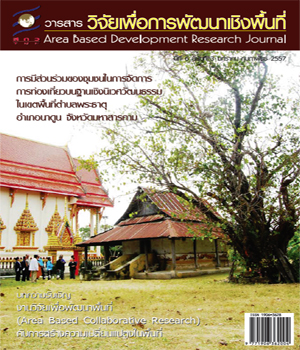ศักยภาพและกลยุทธ์ระบบการบริหารจัดการของโรงงานเซรามิกขนาดเล็กในการเตรียมความพร้อมเพื่อการดำรงอยู่อย่างยั่งยืน : กรณีศึกษาจังหวัดลำปาง
Main Article Content
Abstract
งานวิจัยนี้เป็นงานวิจัยเชิงคุณภาพและเชิงสำรวจ มีวัตถุประสงค์เพื่อ วิเคราะห์ศักยภาพ และหากลยุทธ์ในการเตรียมความพร้อมด้านระบบการบริหารจัดการของโรงงานเซรามิกขนาดเล็กที่มีคนงานไม่เกินแห่งละ 20 คน ในพื้นที่อันเป็นที่ตั้งของโรงงานเซรามิกขนาดเล็กจำนวน 20 แห่ง ซึ่งอยู่ในเขตอำเภอเมือง อำเภอแม่ทะ และอำเภอเกาะคา จังหวัดลำปาง วิธีการดำเนินการวิจัยแบ่งออกเป็น 3 ขั้นตอน ขั้นตอนแรกการจัดประชุมเพื่อวางกรอบและวางแผนการดำเนินงาน ขั้นตอนที่ 2 การลงพื้นที่และจัดเก็บข้อมูลเพื่อใช้สำหรับวิเคราะห์หากลยุทธ์และขั้นตอนที่ 3 ลงพื้นที่เพื่อคืนข้อมูล แลกเปลี่ยนเรียนรู้ และตรวจสอบข้อมูลด้านศักยภาพระบบบริหารจัดการของโรงงานเซรามิก
เครื่องมือที่ใช้และวิธีการในการเก็บข้อมูล ประกอบด้วยการศึกษาจากเอกสาร การสัมภาษณ์ร่วมกับการใช้แบบสอบถาม การสัมภาษณ์เชิงลึก การพูดคุยแลกเปลี่ยนเรียนรู้ และการสังเกตอย่างมีส่วนร่วม มีการตรวจสอบข้อมูลโดยการเปรียบเทียบข้อมูลที่ได้รับจากการลงพื้นที่แต่ละครั้งเพื่อความแม่นยำ และการตรวจเช็คกับผู้ประกอบการในพื้นที่ การวิเคราะห์สังเคราะห์ข้อมูลใช้การจัดหมวดหมู่ข้อมูลหาความสัมพันธ์เชิงเหตุผล และวิเคราะห์ข้อมูลเชิงสถิติและเชิงพรรณนา โดยใช้โปรแกรมวิเคราะห์ข้อมูลสำเร็จรูป รวมทั้งประมวลข้อมูลเชิงคุณภาพมาใช้ในการวิเคราะห์ในบริบทที่เกี่ยวข้องเพื่อความชัดเจน
ผลการวิจัยพบว่า โรงงานเซรามิกขนาดเล็กในจังหวัดลำปางทั้ง 20 แห่งสามารถผลิตสินค้าเฉลี่ยต่อเดือนจำนวน 45,400 ชิ้น โดยใช้ต้นทุนการผลิตเฉลี่ยต่อเดือน 157,735 บาท และได้กำไรเฉลี่ยจากการขายสินค้าประมาณ 330,566 บาท การบริหารจัดการบุคลากรไม่มีโครงสร้างที่ชัดเจน เป็นการบริหารงานแบบครอบครัว แต่ร้อยละ 90 ของโรงงานยังมีการจัดทำระบบบัญชีอย่างเป็นระบบ ด้านการตลาดส่วนใหญ่ไม่มีการวัดหรือประเมินตลาด ด้านการกำหนดราคาสินค้าร้อยละ 50 ของโรงงานกำหนดด้วยตนเอง ร้อยละ 45 กำหนดตามราคาท้องตลาด จากการวิเคราะห์ ศักยภาพพบว่า โรงงานเซรามิกขนาดเล็กจะมีศักยภาพเพียงพอต่อการผลิตสินค้าออกสู่ตลาดได้อย่างต่อเนื่อง มีความพร้อมต่อการดำรงอยู่อย่างยั่งยืนและสามารถประยุกต์ใช้ศักยภาพตนเองเพื่อรองรับการเข้าสู่การเป็นประชาคมเศรษฐกิจอาเซียนได้
จากการนำเสนอกลยุทธ์ของตนเองที่จะสามารถดำรงอยู่ได้อย่างยั่งยืนสรุปได้เป็น 5 กลยุทธ์ด้วยกัน คือ กลยุทธ์ที่ 1 ด้านการผลิต ประกอบด้วย การสต็อกสินค้า การหยุดพักการผลิตชั่วคราว/ลดการผลิต/ชะลอการผลิต การออกแบบสินค้าใหม่ การปรับเปลี่ยนรูปแบบการผลิตเพื่อลดต้นทุนการผลิต การรักษาระดับคุณภาพของสินค้าให้มีคุณภาพ การยึดหลักการพึ่งตนเองเพื่อลดต้นทุนการผลิต และการขยายฐานการผลิต กลยุทธ์ที่ 2 ด้านบุคลากร ประกอบด้วย การปรับเปลี่ยนรูปแบบการจ้างแรงงาน การศึกษาเรียนรู้ด้านภาษาต่างประเทศ การปรับเปลี่ยนวิธีคิดการมองหามุมมองใหม่ๆ อยู่เสมอการปรับเปลี่ยนรูปแบบการบริหารจัดการ เป็น “ครอบครัว”ผู้ประกอบการเป็นทั้งผู้บริหารและปฏิบัติการ และแรงงานสามารถปฏิบัติงานได้หลากหลาย กลยุทธ์ที่ 3 ด้านการเงิน ประกอบด้วย การใช้ระบบเงินหมุนเวียน กลยุทธ์ที่ 4 ด้านข้อมูลข่าวสารประกอบด้วย การเข้าร่วมกิจกรรมต่างๆ ที่เกี่ยวข้องเพื่อเพิ่มพูนองค์ความรู้ และ กลยุทธ์ที่ 5 ด้านการตลาด ประกอบด้วย การยึดหลักเศรษฐกิจพอเพียง การรักษาฐานลูกค้าประจำและการสร้างเครือข่ายด้านการตลาด
Potentials and Strategies Management of Small Ceramic Factory in Preparation for the Sustainable Existence : A Case Study of Lampang Province
This research is qualitative and survey research. The purpose is to analysis of potential and strategies to prepare the system for management of small ceramic factory with no more than of 20 man of workers in the area as the location of the ceramic factory, a small number of 20. located in Muang , Mae Tha and KoKha, Lampang. The experiments were divided into 3 periods. The first period was meeting to lay the framework and implementation plan. The second period was into the area to be used for storage and analysis strategies. And the third period was restore the data and the information management capacity of presenting strategies of the management of small ceramic factory.
Tools and methods used to collect data from the document study, interviews with questionnaires, depth interviews, discussed learning and observation of participation. Checked by comparing the data received from the area each time for accuracy and check with the operators in the area.Analysis of synthetic data using a data classification causal relationship. And analyze statistical data and descriptive. Using data analysis ready including the process used to analyze qualitative data in the relevant context for clarity.
The results showed that the small ceramic factory in Lampang all 20 can produce 45,400 pieces per month of the average production cost 157,735 Baht per month and average profit on the sale of approximately 330,566 Baht. Management personnel have a clear structure. This family-owned operation. 90 percent of the plant also presents a systematic accounting system. Most marketing does not measure or evaluate the market. Pricing products 50 percent to 45 percent of the plant manually set the market price. The analysis found potential small ceramic factory will have a capacity to produce enough goods to market continuously. Are ready to sustainable existence and their potential applications to support the AEC into it.
From offering their own strategies that can maintain sustainable summarized into 5 strategies together. The first strategy production consisted of stock product, stop production temporarily/reduce production/production delay, designing new products, modifying the production model to reduce production costs, maintain the quality of the product quality, applying principle of self-dependent to reduce production costs and expanding the manufacturing base. The second strategy personnel consisted of modifying form of employment, learning foreign languages, changing the way you think, looking for new perspectives, changing patterns of into family style. Entrepreneurs could act in many positions such as administrator and performer and labor could perform variously. The third strategy finance consisted of using the system working capital. The fourth strategy information consisted of participation in activities related to knowledge enhancement and the five strategy marketing consisted of principle of sufficiency economy, retaining customers, and network construction marketing.
Article Details
Area Based Development Research Journal values copyright protection and licensing to safeguard author rights and facilitate the appropriate dissemination of research. Our policies ensure openness, accessibility, and attribution. Authors retain copyright ownership, and articles are published under a Creative Commons Attribution License (CC BY), allowing sharing, adaptation, and proper attribution. Authors have the freedom to publish under the CC BY license, granting broad reuse and distribution permissions. The journal supports posting articles on third-party repositories, adhering to institutional and funding restrictions. Author guidelines detail copyright and licensing requirements, empowering authors with knowledge about their rights and responsibilities. These policies cultivate an environment of collaboration, openness, and responsible sharing, benefiting authors and the research community while honoring intellectual property rights.


